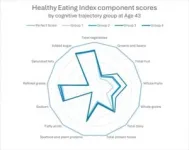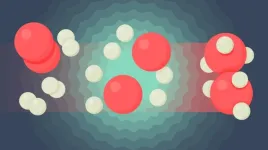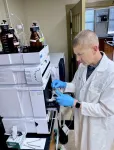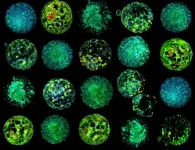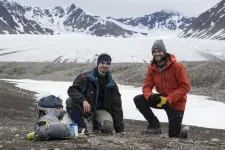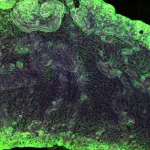(Press-News.org) URBANA, Ill. — Domesticated animals play a prominent role in our society, with two-thirds of American families enjoying the companionship of pets and many others relying on animal products for their nutritional needs. But the process of domestication remains a bit of a mystery. Convincing wild animals they are safe enough to coexist and mate in enclosures and in close proximity to humans and other animals is no small feat. What does it take behaviorally and genetically for that to happen?
For the most part, the animals we’ve domesticated have been docile for so long that there’s no easy way to go back and study the transition from wild to tame. A notable exception is the domestication of red foxes — raised in captivity for their fur — starting in 1896 on Canada’s Prince Edward Island. A team from the University of Illinois Urbana-Champaign traced the process from its beginnings on the island to captive fox populations around the world, including some still in operation today.
“We have the historical documents, we have genetic information about wild fox populations all over the world, and we obtained samples from foxes bred in North America and Eurasia. So we can really dig into the question of how foxes were domesticated and how their genetics were shaped by geography and time,” said lead study author Halie Rando, an assistant professor at Smith College who completed her doctoral research in the Illinois Informatics Institute, now in the School of Information Sciences, at Illinois.
Rando, along with Illinois animal sciences professor Anna Kukekova and their collaborators, analyzed new and previously published mitochondrial DNA data from wild fox populations and from 10 captive populations in North America and Eurasia, including the site of the famous Russian fox domestication experiment. They then cross-referenced historical records related to the intercontinental trade of foxes, changing fur demand and farm sizes, and breeding practices. Together, the data allowed them to determine the geographical origins of farmed foxes worldwide and understand the role of genetic diversity in the domestication process.
“When we do population genetics research, we're able to uncover history forensically,” Rando said. “Looking at signatures that are in present populations, we can make inferences about the past.”
Early fox farmers were motivated by the demand for the silver variant of red foxes. Trying to trap rare silver foxes from the wild was unreliable and difficult, but breeding them in captivity had its own challenges.
“The foxes were very hard to breed on the farms because they would get really stressed out and die or kill their offspring. It took a long time for them to figure out how to set up the breeding enclosures to reduce stress. Along the way, they were selecting for individuals that were better suited to the farm environment,” Rando said. “They also managed to select for the silver fur color. Even without knowing any genetics, they figured out how to crack the code.”
After that, the industry boomed, with Canadian foxes being exported across the world. The genetic analysis showed that every captive population the researchers surveyed — even those in Eurasia — originated from wild North American foxes. In fact, there were no traces of genetic markers from Eurasian wild fox populations, suggesting any attempts at domesticating local populations were abandoned or overtaken by North American genetics.
“This study helps to answer questions researchers have asked for years about the geographic origin and genetic background of these fox populations,” Kukekova said. “Furthermore, some farm foxes may have mixed with native foxes through release events over the years in different locations. Occasionally, unexpected gene signatures show up in native populations, so our study may help to explain where they’re coming from.”
World War II interrupted demand, and the industry never recovered in North America. In the USSR, however, fox farms quickly rebounded, aided by the government-supported fur industry.
Overall, the genetic pattern reflects the more stable history of breeding in Eurasia. Although all the farmed foxes in the study were found to originate from North American wild foxes, populations in Eurasia were more genetically diverse, with greater representation from Alaskan and western U.S. genotypes in addition to common genotypes from Eastern Canada.
“Some gene signatures were very rare and found only in certain Eurasian farm populations,” Rando said. “The presence of these rare signatures, along with more diversity overall in Europe, could be due to more stable population sizes there after World War II, whereas those rare types may have been lost when North American farms collapsed.”
The study also sheds light on the famous Russian Farm Fox experiment, started in 1959 at the Institute of Cytology and Genetics (ICG) in Novosibirsk. The study originated with the selection of farm-bred foxes that showed the least avoidant behaviors around humans. Through successive generations, scientists selectively bred foxes with tame behaviors, eventually resulting in foxes as friendly as the family dog.
The current study sampled that population and analyzed it along with the others, finding no unique genetic origins for the Russian foxes. To Rando, this suggests that farm-bred foxes may have the same underlying capacity to develop friendly behaviors.
“I’d say we pretty conclusively demonstrated that the foxes in Novosibirsk are not meaningfully different from other farm-bred foxes in terms of their genetic origins. We also found that the populations in Novosibirsk were among the most genetically diverse captive populations, likely due to their meticulous pedigree records and carefully planned breeding,” she said.
Kukekova added, “It's informative to know that this one successful endeavor in Prince Edward Island really had a huge effect on modern populations that persists to this day. The model can help us study domestication broadly and find gene networks leading to tame behavior, which is something that humans have been interested in for a very long time.”
The study, “Missing history of a modern domesticate: Historical demographics and genetic diversity in farm-bred red fox populations,” is published in the Journal of Heredity [DOI: 10.1093/jhered/esae022].
Kukekova is also affiliated with the Carl R. Woese Institute for Genomic Biology.
END
Genetic patterns of world’s farmed, domesticated foxes revealed via historical deep-dive
2024-07-01
ELSE PRESS RELEASES FROM THIS DATE:
Flatiron Institute launches initiative for computational catalysis
2024-07-01
The Simons Foundation’s Flatiron Institute has launched a new initiative focused on advancing the science of catalysis. The Initiative for Computational Catalysis (ICC), which began operations on July 1, will harness computational techniques to study and design substances called catalysts that speed up chemical reactions. Such substances promise to be instrumental in clean energy generation and in reducing greenhouse gas emissions from industrial processes.
“These are big questions that are hard to address from the very first step of the ...
NRL intern discovers a new pulsar buried in a mountain of data
2024-07-01
WASHINGTON – U.S. Naval Research Laboratory (NRL) Remote Sensing Division intern, Amaris McCarver, along with a team of astronomers, discovered the first millisecond pulsar in the stellar cluster Glimpse-CO1 and recently published findings in the Astrophysical Journal.
Pulsars are natural laboratories for studying the behavior of matter under extreme gravitational and magnetic fields - conditions difficult or impossible to replicate on Earth.
They also function as natural timekeepers. Precise timing of the observed pulses from an array of pulsars offers a means to ...
Farm-to-table study reveals why whole grains are healthiest
2024-07-01
Chicago (July 1, 2024) — What does whole wheat have that refined flour lacks? A new study reveals key differences in nutrient content along with exactly where nutrients are lost — and sometimes gained — along the journey from farm to table.
While previous studies have assessed the nutrients contained in various crops or in food products, the new study is among the first to bridge the two by tracing how processing and baking influence nutrient composition at each step.
Researchers report that levels of major minerals were cut by nearly three-quarters ...
Revolutionary technology promises to reduce the time to pregnancy in assisted reproduction
2024-07-01
A new technology developed by the "Bioengineering in Reproductive Health" team at the Institute for Bioengineering of Catalonia (IBEC) is able to visualise the metabolism of embryos obtained through in vitro fertilisation in order to decide which are most likely to implant correctly in the uterus and reaching full-term. It is a more accurate and reliable technique than traditional methods.
The revolutionary method, called METAPHOR", generates 3D images that reveal the colours present in the embryo in a completely non-invasive way. Certain naturally fluorescent compounds in the embryo's metabolism are also key to processes such as cellular respiration ...
Shrinking glaciers: Microscopic fungi enhance soil carbon storage in new landscapes created by shrinking Arctic glaciers
2024-07-01
Melting Arctic glaciers are in rapid recession, and microscopic organisms colonise the newly exposed landscapes. Dr. James Bradley, Honorary Reader in Arctic Biogeochemistry in the School of Biological and Behavioural Sciences at Queen Mary University of London, and his team, have revealed that yeasts play an important role in soil formation in the Arctic after glaciers have melted away.
Roughly 10% of Earth’s land surface is covered by glacial ice. However, glaciers are retreating ever further and ever faster because of global warming. As they do, ...
UMD-led study finds one-third of Indonesia’s deforested land left idle
2024-07-01
EMBARGOED UNTIL JULY 1, 2024 AT 3:00 PM U.S. EASTERN TIME
According to a new study published in the Proceedings of the National Academy of Sciences, extensive land areas have been left sitting idle after tropical forests were cleared in Indonesia, a country renowned for its biodiverse rainforests and carbon-rich peatlands. Since 1990, the country has lost 25% of its old-growth forest, and while over one-quarter (7.8 million hectares) of Indonesia’s deforested lands have been converted to palm oil plantations since ...
University of Cincinnati study: Overlooked brain organ plays key role in promoting brain repair after stroke
2024-07-01
University of Cincinnati researchers have pioneered an animal model that sheds light on the role an understudied organ in the brain has in repairing damage caused by stroke.
The research, published July 5 in the Proceedings of the National Academy of Sciences, sought to learn more about how the adult brain generates new neurons to repair damaged tissue.
The research team focused on the choroid plexus, a small organ within brain ventricles that produces the brain’s cerebrospinal fluid (CSF). CSF circulates throughout the brain, carrying signaling molecules and other factors thought to be important for maintaining brain function. However, prior to this study, little ...
Harvard researchers find that gratitude is a useful emotional tool in reducing desire to smoke
2024-07-01
Smoking continues to rank as the foremost preventable cause of premature death. In a paper published this week in the Proceedings of the National Academy of Science (PNAS), Harvard researchers report findings that evoking feelings of gratitude in people who smoke helps reduce their urge to smoke, and increases their likelihood of enrollment in a smoking cessation program. They note that these findings could inform newer approaches to public health messaging campaigns that aim to reduce so-called “appetitive” risk behaviors like smoking, drinking, and drug use.
The research team built on the Appraisal Tendency Framework, a theoretical model of emotiona and decision making, ...
Researchers disclose the effect of social media use on the mental health of college students during the pandemic
2024-07-01
The COVID-19 pandemic had an unprecedented effect on college students’ mental health: symptoms like anxiety and major depression in young adults ages 18-25 increased significantly compared to before the pandemic.
A new study from researchers at the University of North Carolina at Chapel Hill looks at a possible contributing factor to the worsening trends in mental health: social media.
We know that college students and adolescents are using social media more. Last May, the US Surgeon General issued an advisory on social media and youth mental ...
July Issues of APA Journals cover new research on pharmacogenomics, ADHD medication use, associations between mental health and cardiometabolic complications later in life, and more
2024-07-01
WASHINGTON, D.C., July 1, 2024 — The latest issues of four American Psychiatric Association journals, The American Journal of Psychiatry, Psychiatric Services, American Journal of Psychotherapy and Psychiatric Research and Clinical Practice are now available online.
The July issue of The American Journal of Psychiatry brings together research on affective disorders, pharmacogenomics, and psychiatric illness-related cardiometabolic problems. Highlights include:
• Genome-Wide Association Study of Treatment-Resistant Depression: Shared Biology With Metabolic Traits.
• Pharmacogenomic Clinical ...

